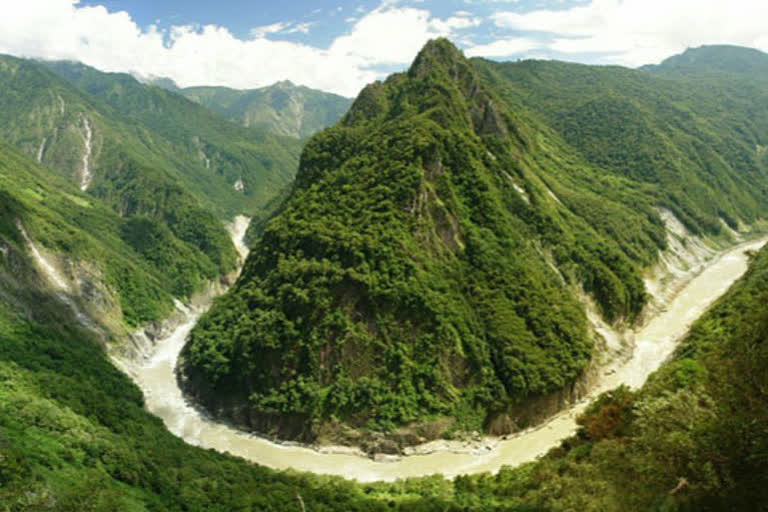Hyderabad: China is on the verge of unleashing a hurricane of water projects to attack its neighbours. Beijing's evil design, which is already thrusting water scarcity on Southeast Asian countries with huge irrigation projects, has recently been aimed at India.
China's massive hydropower project on the Brahmaputra River is set to become a curse for India as well as Bangladesh. India is on high alert to mitigate the damage caused by the China dam. It has announced that it will build a multi-purpose reservoir in Arunachal Pradesh on the Brahmaputra.
The Brahmaputra originates in Tibet, flows through Arunachal Pradesh and Assam in India and reaches Bangladesh. While Delhi has suggested to Bejing that projects should be built in a way that does not harm India, the latter seemingly agrees to it.
But it has always been proven that China's words have a different, often an opposite connotation. China's plot is to use rivers, hydropower, irrigation projects, and canals as a weapon to exert political pressure and the threat to the enemy.
Without keeping India, Bangladesh and Southeast Asia informed, it has built 11 dams on the Tibetan River and eight on the Mekong River and is preparing to build three more shows the malicious nature of China. Now it is preparing the ground to construct a heavy project just 30 km from the Indian border.
China's water wars
China, which has so far built 55 reservoirs on the Tibetan Plateau, will continue its water wars. While the projects on the Brahmaputra are causing damage to India and Bangladesh, the Mekong projects are hurting Myanmar, Thailand, Laos, Cambodia and Vietnam. It has become China’s policy to harm the neighbouring countries to fulfil the country's needs.
Already most states in China are facing severe water shortage. Not only drinking water and irrigation but also the water requirement for industries is increasing.
According to local sources, China has decided to build a large-scale project on the Yarlung-Tsangpo River (Tibetan name for the Brahmaputra River) to meet its water and electricity demand.
Water requirement for India is also increasing. More than a third of the world's population lives in China and India, but China's share of the world's water resources is seven per cent, while India's is only four per cent.
Projects built on the Indus and Brahmaputra rivers in Pakistan-occupied Kashmir and Tibet could prevent water from reaching India during the summer. If the gates of the projects are raised during the monsoon season, the flood water will destroy Assam and Arunachal Pradesh.
Earlier, China promised to provide advance information on water release between June and October each year but stopped sharing of information after 2017 Doklam conflict. Although the information sharing was restored again in 2018, there is no guarantee that using water as a weapon will not be considered stopped in the future.
Anticipating it, India has decided to build a 10,000 MW hydropower project in Arunachal Pradesh to withstand the flow of the Brahmaputra. Through the construction of dams, China has been abusing the advantage of water resources it inherited since its invasion of Tibet.
It is building huge projects to divert Tibetan rivers to water-scarce areas in northern China. It has plans to divert the Brahmaputra water to Xinjiang province by drilling a thousand km tunnel.
As of 2016, an estimated 87,000 dams have been built on rivers. The construction of the dams is set to intensify as Beijing hopes to reduce its use of fossil fuels such as coal and oil and rely heavily on solar and hydropower. However, the neighbouring countries are paying a heavy price for this.
When the Mekong River waters depleted last year, China bluffed that insufficient rain as the reason. But, at that time the reservoirs built on the Mekong in China were full of water.
Since the water was not released downstream, sugar production in Thailand, which relies on the Mekong, has suffered the worst sugarcane production in nine years. Rice yields in Vietnam have fallen sharply. Water levels have dropped in Laos and Cambodia.
India is taking precautions to save Assam and Arunachal Pradesh from China's plans to build projects on the Brahmaputra in future. India should work with countries affected by the Chinese dams to ensure India's water security.
Monopoly on the third pole
After the Arctic and Antarctic, Tibet enjoys a large presence of glaciers. Hence it is called the third pole. The Indus, Sutlej, Brahmaputra, Mekong, Iravati, Yangtze, and Yellow River originate from the 46,000 glacial rivers of the Tibetan plateau. These are the perennial rivers of the Asian continent and are vital for the well-being of the region.
The Brahmaputra and Indus rivers, which originate in Tibet, have long been used for agriculture in much of north-eastern and northern India. A total of ten major rivers originate in Tibet and are lifelines to South and Southeast Asia.
Since the invasion of Tibet, China acquired the advantage of threatening neighbouring countries with water as a weapon. However, glaciers are melting faster due to climate change. Scientists predict that this will cause water levels in the Tibetan rivers to rise by 2050 and then decrease.
They say one-third of Tibet's glaciers will be drained by 2100. The Tibetan glaciers have been melting at 247 square kilometres of snow annually since the 1950s. As a result, the water, energy and food security of Asian countries are at risk.
Floods, landslides and mud-floods are on the rise in Tibet due to the ecological changes on the glaciers. The ill-effects of these are not limited just to Tibet.
Read: Carefully monitoring all developments on Brahmaputra: MEA



